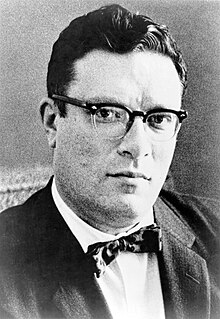
Isaac Asimov was an American writer and professor of biochemistry at Boston University. He was known for his works of science fiction and popular science. Asimov was a prolific writer, and wrote or edited more than 500 books. He also wrote an estimated 90,000 letters and postcards.

The Foundation series is a science fiction book series written by American author Isaac Asimov. First published as a series of short stories in 1942–50, and subsequently in three collections in 1951–53, for thirty years the series was a trilogy: Foundation, Foundation and Empire, and Second Foundation. It won the one-time Hugo Award for "Best All-Time Series" in 1966. Asimov began adding new volumes in 1981, with two sequels: Foundation's Edge and Foundation and Earth, and two prequels: Prelude to Foundation and Forward the Foundation. The additions made reference to events in Asimov's Robot and Empire series, indicating that they were also set in the same fictional universe.
The Galactic Empire series is a science fiction sequence of three of Isaac Asimov's earliest novels, and extended by one short story. They are connected by their early place in his published works and chronological placement within his overarching Foundation Universe, set around the rise of Asimov's Galactic Empire, between the Robot and Foundation series to which they were linked in Asimov's later novels.
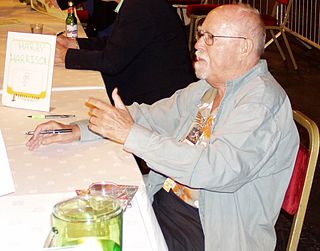
Harry Max Harrison was an American science fiction author, known mostly for his character The Stainless Steel Rat and for his novel Make Room! Make Room! (1966). The latter was the rough basis for the motion picture Soylent Green (1973). Long resident in both Ireland and the United Kingdom, Harrison was involved in the foundation of the Irish Science Fiction Association, and was, with Brian Aldiss, co-president of the Birmingham Science Fiction Group.
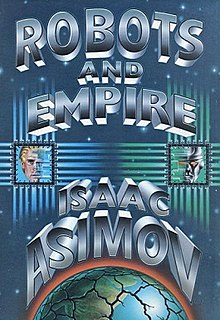
Robots and Empire is a science fiction novel by the American author Isaac Asimov, published by Doubleday Books in 1985. It is part of Asimov's Robot series, which consists of many short stories and five novels.

Foundation is a science fiction novel by American writer Isaac Asimov. It is the first published in his Foundation Trilogy. Foundation is a cycle of five interrelated short stories, first published as a single book by Gnome Press in 1951. Collectively they tell the early story of the Foundation, an institute founded by psychohistorian Hari Seldon to preserve the best of galactic civilization after the collapse of the Galactic Empire.
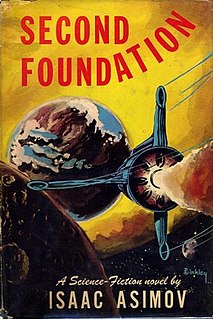
Second Foundation is the third novel published of the Foundation Series by American writer Isaac Asimov, and the fifth in the in-universe chronology. It was first published in 1953 by Gnome Press.
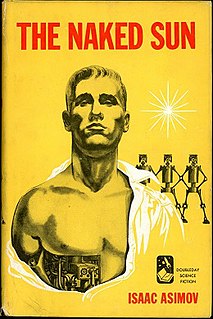
The Naked Sun is a science fiction novel by American writer Isaac Asimov, the second in his Robot series. Like its predecessor, The Caves of Steel, this is a whodunit story. It was first published in book form in 1957 after being serialized in Astounding Science Fiction between October and December 1956.
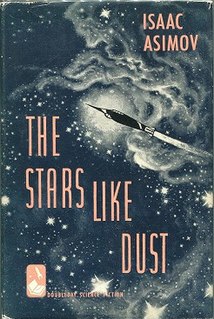
The Stars, Like Dust is a 1951 science fiction mystery book by American writer Isaac Asimov.
"Blind Alley" is a science fiction short story by American writer Isaac Asimov. It was first published in the March 1945 issue of Astounding Science Fiction, and later included in the collection The Early Asimov (1972).
"Reason" is a science fiction short story by American writer Isaac Asimov, first published in the April 1941 issue of Astounding Science Fiction and collected in I, Robot (1950), The Complete Robot (1982), and Robot Visions (1990). It is part of Asimov's Robot series, and was the second of Asimov's positronic robot stories to see publication.
"Mother Earth" is a science fiction novella by American writer Isaac Asimov. It was written from September 1 to October 10, 1948, and published in the May 1949 issue of Astounding Science Fiction. It was republished in Asimov's 1972 short story collection The Early Asimov.
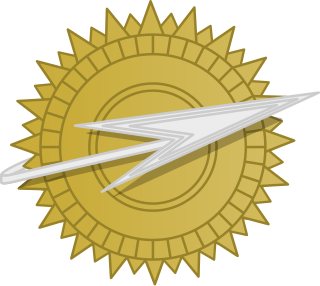
The Galactic Empire is an interstellar empire featured in Isaac Asimov's Robot, Galactic Empire, and Foundation series. The Empire is spread across the Milky Way galaxy and consists of almost 25 million planets settled exclusively by humans. For over 12 millennia the seat of imperial authority was located on the ecumenopolis of Trantor, whose population exceeded 40 billion, until it was sacked in the year 12,328. The official symbol of the empire is the Spaceship-and-Sun. Cleon II was the last Emperor to hold significant authority. The fall of the empire, modelled on the fall of the Roman Empire, is the subject of many of Asimov's novels.
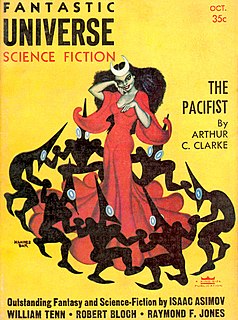
"First Law" is a science fiction short story by American writer Isaac Asimov, first published in the October 1956 issue of Fantastic Universe magazine and later collected in The Rest of the Robots (1964) and The Complete Robot (1982). The title of the story is a reference to the first of the Three Laws of Robotics.
"Victory Unintentional" is a humorous science fiction short story by American writer Isaac Asimov, published in the August 1942 issue of Super Science Stories and included in the collections The Rest of the Robots (1964) and The Complete Robot (1982).
"Not Final!" is a science fiction short story by American writer Isaac Asimov, originally published in the October 1941 issue of Astounding Science Fiction, and included in the 1972 collection The Early Asimov. Its sequel, "Victory Unintentional", is a robot story. These are two of the few stories by Asimov to postulate non-human intelligences in the Solar system.
"Homo Sol" is a science fiction short story by American writer Isaac Asimov. It was first published in the September 1940 issue of Astounding Science Fiction and reprinted in the 1972 collection The Early Asimov. It deals with the proposed acceptance into a galactic federation of hominid civilizations of the hominids of newly discovered Earth.
"The Imaginary" is a science fiction short story by American writer Isaac Asimov. It first appeared in the November 1942 issue of Super Science Stories and was reprinted in the 1972 collection The Early Asimov. Following the sale of "Half-Breeds on Venus", which was a sequel to "Half-Breed", Asimov suggested to Astounding Science Fiction editor John W. Campbell that he write a sequel to the story "Homo Sol". Campbell was unenthusiastic, but agreed. Since "The Imaginary" lacked the human-alien conflict that he had liked in the earlier story, Campbell ultimately rejected it. "The Imaginary" was the twenty-first story written by Asimov, and the twenty-ninth to be published. Due to the peculiar workings of the science fiction magazine publishing industry, "The Imaginary" appeared a month after the third story in the Homo Sol Trilogy, "The Hazing".
"The Hazing" is a science fiction short story by Isaac Asimov. It was first published in the October 1942 issue of Thrilling Wonder Stories and reprinted in the 1972 collection The Early Asimov. Discussing the story in The Early Asimov, the author noted that it is set in the same fictional universe as his earlier stories "Homo Sol" and "The Imaginary", but featured different characters. "The Hazing" was the thirtieth story written by Asimov, and the twenty-eighth to be published. Due to the peculiar workings of the science fiction magazine publishing industry, the story appeared a month before "The Imaginary".
"No Connection" is a science fiction short story by American writer Isaac Asimov. It was first published in the June 1948 issue of Astounding Science Fiction and reprinted in the 1972 collection The Early Asimov.








